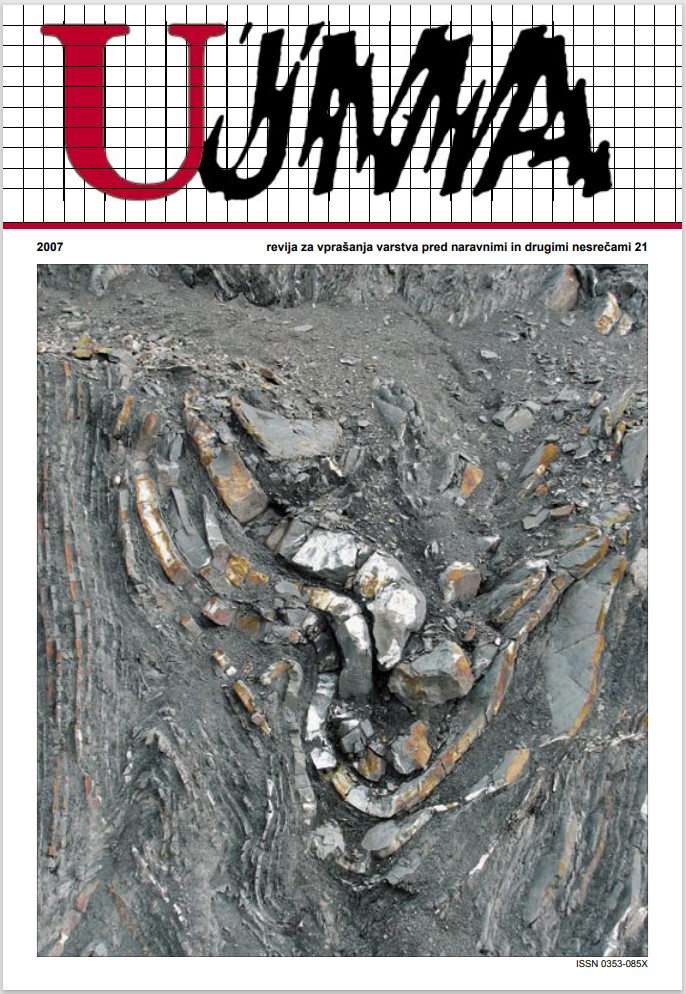AIRBORNE LASER SCANNING (LiDAR) OF IDRIJA AND RAVNE FAULTS IN WESTERN SLOVENIA
Abstract
Airborne laser scanning, or LiDAR, is a relatively new method of remote sensing which is used to build very detailed digital elevation models with a resolution of a few meters. Since some laser beam pulses reach the ground even in areas covered by forest, it is also possible in this case to construct the bare ground elevation model, which is not possible with other techniques such as photogrammetry. This is very valuable in geomorphologic analyses of active faults in forested terrain, in order to study their seismotectonic characteristics and to assess the earthquake hazard. The method was successfully applied to study the tectonic characteristics of Idrija and Ravne faults in Western Slovenia. This was the first application of airborne laser scanning for the purpose of mapping active faults in Europe. On the Idrija fault, with the help of the data collected we identified the area suitable for further paleoseismological investigations and on the Ravne fault, we obtained new data about its segmentation. Both are important for understanding past seismicity and assessing the seismogenetic potential of the two faults.
References
Bajc, J., Aoudia, A., Sarao, A., Suhadolc, P., 2000. The 1998 Bovec-Krn mountain (Slovenia) earthquake sequence. Geophys. Res. Lett., 28, 1839–1842.
Buser, S., 1986. Osnovna geološka karta 1 : 100.000, list Tolmin in Videm; tolmač. Zvezni geološki zavod, 103 str.
Cunningham, D., Grebby, S., Tansey, K., Gosar, A., Kastelic, V., 2006. Application of airborne LiDAR to mapping seismogenic faults in forested mountainous terrain, SE Alps, Slovenia. Geophys. Res. Lett., 33, L20308, 5 str.
Fitzko, F., Suhadolc, P., Aoudia, A., Panza, G. F., 2005. Constraints on the location and mechanism of the 1511 Western Slovenia earthquake from active tectonics and modeling of macroseismic data, Tectonophysics, 404, 77–90.
Flood, M., Gutelius, B., 1997. Commercial implication of topographic terrain mapping using scanning airborne laser radar. Photogrammetric Engineering and Remote Sensing, 63, 327–329.
Gentile, G. F., Renner, G., Riggio, A. M., Slejko, D., Zacchigna, M., 1984. Il terremoto del 26 marzo 1511 nelle Alpi orientali. V: Finalita ed esperienza della rete sismometrica del Friuli – Venezia Giulia, Trst.
Gosar, A., 2004. Paleoseizmologija – izziv pri ocenjevanju potresne nevarnosti v Sloveniji. Ujma, 17–18, 257–264.
Haugerud, R., Harding, D. J., Johnson, S. Y., Harless, J. L., Weaver, C. S., Sherrod, B. L., 2003. High-resolution Lidar topography of the Puget Lowland, Washington – a bonanza for earth science, GSA Today, 13, 4–10.
Kastelic, V., Cunningham, D., 2006. Multi-disciplinary investigation of active strike-slip fault propagation in the Julian Alps: The Ravne fault, NW Slovenia, Geophysical Research Abstracts, 8, 05018.
Lapajne, J., 1988. Veliki potresi na Slovenskem – II. Ujma 2, 70–74.
Ribarič, V., 1979. The Idrija earthquake on March 26, 1611 – a reconstruction of some seismological parameters. Tectonophysics, 53, 315–324.
Zupančič, P., Cecić, I, Gosar, A., Placer, L., Poljak, M, Živčić, M., 2001. The earthquake of 12 April 1998 in the Krn Mountains (Upper Soča valley, Slovenia) and its seismotectonic characteristics. Geologija, 44, 169–192.
Downloads
Published
Issue
Section
License

This work is licensed under a Creative Commons Attribution-NonCommercial-NoDerivatives 4.0 International License.
The articles are made available to the public under Creative Commons Attribution-NonCommercial-NoDerivatives 4.0 International (CC BY-NC-ND 4.0).


